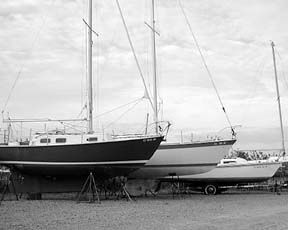
As has been done several times in the past, Practical Sailor presents here another New and Used Sailboats price guide.
Its nothing that a prospective sailboat buyer couldnt do, if he had about 40 hours spare time.
Getting a handle on used boat prices, comparable figures on boat size related to boat age, is easy.
First you buy a lot of sailboat magazines, like Cruising World, Sail, Sailing, some good regional magazines and Soundings…especially Soundings, which has evolved in the last decade or so into the dominant print marketplace for boats.
Next, you pour over these publications, examining classified and display ads for used boats of all kinds, noting down their size, age and price.
If you like you can even do some rudimentary arithmetic and get a price-per-foot or price-per-pound. Youll find that it ranges from as low as $200 a foot for small boats that are more than 25 years old to about $5,000 a foot for slightly used big boats. Per pound figures in the same categories range from about $1 to around $7.50.
New boat prices are a bit more difficult to acquire. Calls to most manufacturers will lead you to savvy spokesmen who know just how much their boats cost, not just in sail-away condition but what the average buyer pays in all-up American dollars. Theyre a joy to deal with.
Some manufacturers are much more guarded about retail, sail-away or as-customarily-equipped prices.
A few are very slow to return calls and, when they do, belabor the issue with qualifications… With or without a trailer? How much equipment? Delivered where? Etc.
A rare few builders (Catalina among them) simply refuse to supply such information, and refer you to their dealers.
To summarize, comparing prices is a chore. Practical Sailors chart does it for you.
If you wish to know how much boat you can buy for a given amount of money you can come up with, the chart will show you a few new boats and a lot of used boats.
For instance, for $75,000 you can buy a new 27′ Com-Pac, a J-92, or a Marshall catboat. For the same amount you can buy maybe a 6-year-old Catalina 32, a 10-year-old Island Packet 29, a 15-year-old Pearson 44, a 20-year-old Tartan 37 or even a 37-year-old Little Harbor 45.
The boats shown on the chart are real offerings. The used-boat figures are asking prices, which, except in the case of extremely desirable boats that rarely come on the market, can be adjusted downward.
What the chart can’t tell you is the condition of the boats, how well theyve been maintained, or if theyve been upgraded over the years.
A complete overhaul, refit or refinishing (inside and out) plus a new engine, new sails or even self-tailing winches, can add a great deal-perhaps as much as 25%-to a used boats price. Conversely, a boat in poor condition, needing work, can be worth up to 50% less.
The BUC Used Boat Price Guide, which reflects current selling prices, includes a system to adjust prices for a boats location, whether it has been used in fresh or saltwater and, on a six-level scale, plus or minus percentage adjustments for a boats condition. The conditions range from Bristol to restorable.
The BUC books, sort of like the blue books used in the automobile business, are published twice each year and cost $183 for the three-volume set.
This Practical Sailor chart serves as a reference for a reader who wants to narrow down the possibilities, to determine how much boat, new or used, he can expect to get for how much money he wants to spend.
For someone who already owns a boat, the chart is a reference source to determine how much its worth. For those who want to stick right where they are, its just for fun. Enjoy.
Click here to view “2001 Sailboat Prices: New & Used.”



































Please call 913 908 4366